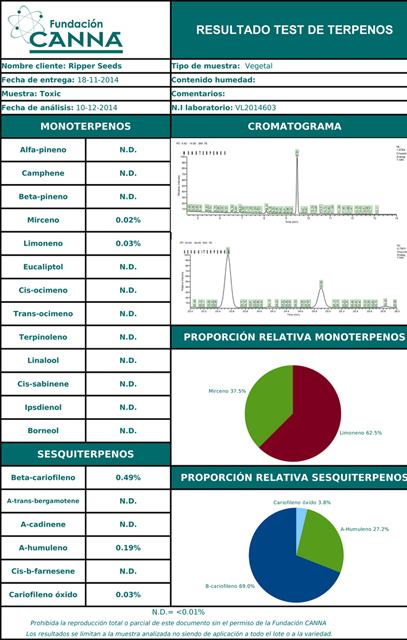Thanks to the Canna Foundation , dedicated to scientific research and analysis of Cannabis, with a very small amount of flower we can become an idea of the terpenoids that a variety has. It should be taken into account that the cultivation and conservation conditions of cannabis seeds can substantially vary the amount of terpenoids in a sample, but in broad terms it will serve as a guide. In this case we analyzed a sample of Black Valley outdoors with almost three months of air drying without any kind of conservation. Given the data, we can assume that the sample will have lost much of the monoterpenes, which are highly volatile, but the relative proportions will remain.

As we can see, in the chromatograph analysis the relative proportion of monoterpenes has a clear predominance of a-pinene monoterpenes with 52.4% and 19.0% of b-pinene. Here is a brief description of the pinene made by the Canna Foundation itself. "Pinene is the common name used to refer to two isomeric bicyclic monoterpenes, alpha-pinene and beta-pinene, which are main components of the resin of pine and other conifers, and precisely for this reason It has this name, although it is the most widely distributed terpene in nature.In fact, we do not only find them in the plant kingdom, since the two compounds are part of the chemical communication system of insects and act as repellants for insects. They have broad antibiotic activity, even against antibiotic resistant pathogens. One of the major therapeutic activities they have is anti-inflammatory, blocking inflammatory signaling of the prostaglandins in a similar way to myrcene. They also have activity as a broncho-dilator in humans when inhaled at low concentrations, and then this effect could influence a greater absorption of cannabinoids in the lungs when smoking, or by vaporizing cannabis with high alpha and beta-pinene content, increasing plasma concentrations and, as a consequence, the effect of cannabinoids. Alpha-pinene is a acetylcholinesterase inhibitor, being able to have favorable effects on memory and being able to decrease the negative effects of THC on memory, although this is currently a mere hypothesis. Apart from its activity, alpha-pinene has also served as a biosynthetic basis for the cannabinoid receptor CB2 ligands. In the different varieties of cannabis, pinene seems to be very stable in its expression, making up around 10% and reaching a maximum of 15-20% of the terpene composition. " As we observed in the analysis, the variety Black Valley has a high relative proportion of this type of terpenoids more predominant in sativas, but in a clearly indica plant. It is not surprising that it was chosen as one of the best varieties for pain in the BestFes contest held at Growmed de Valencia in 2013 given the properties of this type of terpenoid. You can also consult our terpenoid analysis of our seeds of marijuana Toxic.
